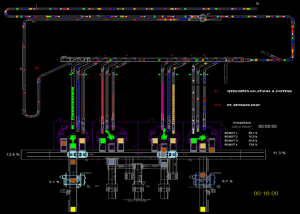By Ian Hobkirk
Managing Director of Commonwealth Supply Chain Advisors
 If you have ever had a chance to view a three-dimensional graphical simulation of a material handling system you will probably agree that on the surface it can be quite impressive. Packages whiz by on conveyors, and the camera perspective can change as the viewer does a fly-by of complex areas of the system such as sorters and automated storage and retrieval systems. The overall finished product is visually appealing, to say the least. But beyond being a way to razzle-dazzle executives into spending a lot of money on a material handling system, simulation software can actually offer tangible benefits to companies in a variety of different situations. There are several instances where companies may wish to consider material handling system simulation.
If you have ever had a chance to view a three-dimensional graphical simulation of a material handling system you will probably agree that on the surface it can be quite impressive. Packages whiz by on conveyors, and the camera perspective can change as the viewer does a fly-by of complex areas of the system such as sorters and automated storage and retrieval systems. The overall finished product is visually appealing, to say the least. But beyond being a way to razzle-dazzle executives into spending a lot of money on a material handling system, simulation software can actually offer tangible benefits to companies in a variety of different situations. There are several instances where companies may wish to consider material handling system simulation.
Design Validation
The company may be in the final stages of designing a complicated material handling system. Numerous questions may still exist regarding whether or not the proposed system will be able to achieve the throughput capacity rate that equipment suppliers may have promised. It may be very difficult to model the time-varying behavior of the system using conventional tools such as spreadsheets. A simulation can use complex algorithms to model the actual performance of the system and verify that it will work as expected. Equipment parameters are loaded into the software as well as human work rate. Complicated nuances can also be incorporated such as operator fatigue over time, absenteeism and other performance factors which do not always perform equally. The software simulation can take all of these factors and determine how the material handling system and workforce will likely perform under an actual workload of specific customer orders that need to be filled and product being positioned in specific bin locations in the distribution center. A tool like this can be a very valuable way to determine if the system will perform as promised.
Predicting Bottlenecks in the System
Material handling simulation can also reveal unexpected problems which may occur in the system. Bottlenecks which may be created by patterns in workflow, work release rules or worker behavior which may not have otherwise been apparent can many times be revealed during a simulation project. Equipment designs may lack necessary surge capacity or even steady-state capacity. Additionally it is possible to model the impact of negative events which can occur, such as equipment failure, absenteeism, operator error and other sub-optimal events. Such events, which may seem minor at the offset, can at times be revealed to have a significant overall negative impact on performance which can only be revealed by using simulation.
Diagnosing and Fixing Problems with Existing Material Handling Systems
As the U.S. economy continues to improve and many material handling equipment manufacturers are seeing increased workloads, there may be a tendency for some companies to take short cuts in design engineering which can result in suboptimal system performance once the equipment is installed. I have personally witnessed two very egregious instances of this occurring in the last several months where the operations fell significantly short of expectations during the busy fourth quarter. Simulation software can be an excellent way to perform cause diagnosis of underperforming material handling systems and test fixes without having to experiment in the live system. Complicated changes to wave building methodology, sortation logic, and other fixes can be effectively simulated using the software without the risks of negative consequences from tampering with a live system on a busy day. Simulation software is especially well suited for this task.
Demonstrating a Future System in Operation
In addition to all of the engineering benefits mentioned above, simulation frequently plays a prominent role in illustrating system behavior for key stakeholders. There are many stakeholders from many companies involved in a typical material handling project. Stakeholders with varied backgrounds and at all organizational levels can generate benefits just from watching a simulation animation, understanding the system design better, asking key questions, and providing feedback to the design team.
In conclusion, there are many reasons why a company should consider a system simulation. In fact, simply the exercise of gathering the data and information required to perform a simulation often reveals many telling things about the operation that may not have otherwise been evident. Companies may also do well to have the simulation performed by an independent firm rather than by one of the manufacturers who is providing equipment for the system. An independent firm can ensure that conservative and balanced assumptions can be made when building the model in order to achieve the most realistic viable result. Any companies in the above situations would do well to consider simulation an integral component of sound distribution center design.
Additional Resources
Commonwealth’s distribution center design whitepaper series provides a structured approach for planning a new or re-designed distribution center.
Read Confidently Committing to a Distribution Center Design – Part I – Storage Design
Read Confidently Committing to a Distribution Center Design – Part II – Throughput Design

